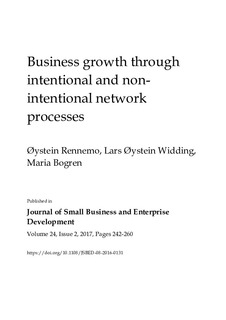| dc.contributor.author | Rennemo, Øystein | |
| dc.contributor.author | Widding, Lars Øystein | |
| dc.contributor.author | Bogren, Maria | |
| dc.date.accessioned | 2018-04-16T11:43:50Z | |
| dc.date.available | 2018-04-16T11:43:50Z | |
| dc.date.created | 2017-03-22T12:45:06Z | |
| dc.date.issued | 2017 | |
| dc.identifier.citation | Journal of Small Business and Enterprise Development. 2017, 24 (2), 242-260. | nb_NO |
| dc.identifier.issn | 1462-6004 | |
| dc.identifier.uri | http://hdl.handle.net/11250/2494232 | |
| dc.description.abstract | Purpose
The purpose of this paper is to examine business growth and explore the “growth mode” among 24 women entrepreneurs participating in a Nordic research, development and networking programme.
Design/methodology/approach
A longitudinal design made it possible to follow entrepreneurial growth as an unfolding and emerging research process with a methodology inductive in nature and driven by empirical findings. The analysis is structured following established procedures for inductive, theory-building research, using guidelines for constant comparison techniques and working recursively between the data and the emerging theory.
Findings
Two processes were found important to understand the women entrepreneurs’ growth mode. The first is interpreted as intentionally driven and relates to the women’s achievement of expanding their knowledge reservoir; the other is non-intentionally driven and a result of uncontrolled network responses. The latter unfolded as a movement towards a preferable macro-actor status for some of the entrepreneurs.
Practical implications
The study calls attention to relevant knowledge preferable to entrepreneurs who face challenges when trying to grow their businesses. The political implications of this study relate to the importance of awareness among governmental organizations and municipal business advisers regarding the effects of entrepreneurial networking.
Originality/value
This study provides an empirically rigorous insight into the processes of entrepreneurial growth. The findings led the authors to develop a conceptual model for business growth, which contributes to the recent stream of literature on how new businesses are growing. | nb_NO |
| dc.language.iso | eng | nb_NO |
| dc.publisher | Emerald | nb_NO |
| dc.title | Business growth through intentional and non-intentional network processes | nb_NO |
| dc.type | Journal article | nb_NO |
| dc.type | Peer reviewed | nb_NO |
| dc.description.version | acceptedVersion | nb_NO |
| dc.source.pagenumber | 242-260 | nb_NO |
| dc.source.volume | 24 | nb_NO |
| dc.source.journal | Journal of Small Business and Enterprise Development | nb_NO |
| dc.source.issue | 2 | nb_NO |
| dc.identifier.doi | 10.1108/JSBED-08-2016-0131 | |
| dc.identifier.cristin | 1460335 | |
| dc.description.localcode | © 2017. This is the authors' accepted and refereed manuscript to the article. The final authenticated version is available online at: https://www.emeraldinsight.com/doi/full/10.1108/JSBED-08-2016-0131 | nb_NO |
| cristin.unitcode | 194,60,25,0 | |
| cristin.unitname | Institutt for industriell økonomi og teknologiledelse | |
| cristin.ispublished | true | |
| cristin.fulltext | postprint | |
| cristin.qualitycode | 1 | |
